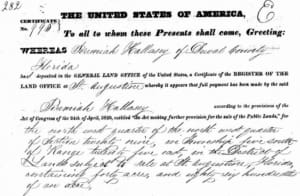It may surprise some to discover that military activity occurred in Clay County, Florida, during the Civil War. Even more surprising to many is evidence demonstrating that those aligned with the South and those aligned with the North both lived, worked, and fought in our community at that critical time in our nation’s history. See for yourself in the timeline and geography of key events below.
There were several northern sympathizers, especially along the St. John’s River. Their presence can be seen in the early discussions regarding secession from the Union. Clay County voted to delay secession in the first round and finally voted to secede in the Secession Convention. Our representative was T. J. Hendricks (no. 32). Lewis Forrester, a free black man living at Magnolia Springs, served in the Union Army. His brother George Forrester served in the Union Navy as well.
The Civil War is well-covered in the publication Parade of Memories. At the time of the writing of Parade of Memories, the location of the battle between Dickison (CSA) and retreating troops in Clay County wasn’t known. It has since been narrowed down to the southern Lake Asbury area. (Battle of Tiger Head or Big Gum Creek)
For a glimpse into the impact homesteading had on Clay County and surrounding areas, read this article compiled by our Archives Supervisor, Homesteading.
Calendar of Civil War Activities 1862 - 1864
June 8, 1862
George Huston, with violent hatred for the Yankees and a fanatical devotion to the South, was an alleged Captain of a guerrilla company. His plantation was just south of Hibernia. Early in June, a Union gunboat with Lt. John G. Sprotson, USN in command of fifty men, quickly surrounded Huston’s house. Lt. Sprotson called, “You are ordered, sir, to surrender to the United States.” Huston’s answer was a shot that killed the lieutenant. A miniature battle raged during which Huston was wounded. He was taken aboard the gunboat and died there eight days later.
Dec. 3, 1862
An attack on the U.S.S. Uncas at Magnolia Springs by Capt. John Westcott CSA.
Apr. 1, 1864
The sinking of the Maple Leaf by underwater torpedoes. The torpedoes were placed on the east side of the St. Johns River by Capt. Bryan (CSA) and Lt. Joshua O’Hern (CSA). O’Hern lived on Black Creek at Doctors Inlet and was the second Sheriff of Clay). The “Maple Leaf Report, Proceedings of a Board of Survey,” and “Maple Leaf, An Extraordinary American Civil War Shipwreck” are available at the Archives.
Apr. 2, 1864
The 1st Georgia Regular Infantry and the Florida Light Artillery entered Laurel Grove; from the point now called Holly Point (Orange Park), they fired their artillery at the Maple Leaf above water.
Apr. 16, 1864
The U.S.S. General Hunter was sunk near the Maple Leaf by another torpedo via Laurel Grove.
July 24, 1864
Shortly after the sinking on the river, Union troops, (40th Mass.), were ordered to destroy the houses along the St. Johns River.
July 25, 1864
The 4th Mass and the 35th USCT had a battle at Highlands with Confederate forces.
July 27, 1864
The 35th USCT had another skirmish with Confederate forces at Whitesville near Middleburg after having a skirmish with the Florida 2nd Cavalry Co. H
August 15, 1864
Federal troops occupied Magnolia
Oct. 23, 1864
The 4th Massachusetts left Magnolia for a raid on Middleburg, with a small skirmish before entering the town.
Oct. 24, 1864
The 4th Mass set fire to a number of buildings, three large warehouses and a hotel. The Federals retreated across the creek, burning the bridge, and headed back to Magnolia. Capt. Dickison and his Fla. 2nd Cavalry were forced to ride about four miles south of Whitesville where the South Prong was shallow enough to cross. They caught up with and ambushed the retreating 4th Mass. The skirmish was probably near but not on Halsey’s Plantation, a little south of the southern tip of Lake Asbury. The 4th Mass left Magnolia with just 55 men. The skirmish lasted about forty minutes. Union: 3 killed, 13 wounded, and 23 captured. Confederate: 2 wounded.

Sept. 24, 1864
A small skirmish between the 4th Mass and the Florida 2nd Cavalry at Magnolia. Shortly after this the Union troops were removed from Clay County for the balance of the war.
Dec. 24,1864
A small Confederate force (3 men) led by William G. Ponce left their CSA headquarters on Doctors Lake and crossed the St. Johns River. They were out to capture the commanding officer at the Union headquarters in St. Augustine and, on the next day, they did. Also captured were Col. William Noble, commanding officer of the 17th Conn Inf. and his party, Capt. Young, 107th Ohio and Lt. Rice, 35th USCT, along with three Union soldiers. The next day, Col. Noble was turned over to Col. Turney at the CSA headquarters on Doctors Lake. Col. William H. Noble ended up at Andersonville Prison for the balance of the war. William Ponce was captured by Union scouts on Jan 17, 1865 at Doctors Lake and was sent to the Union Prison at Hilton Head S.C. for the balance of the war.

